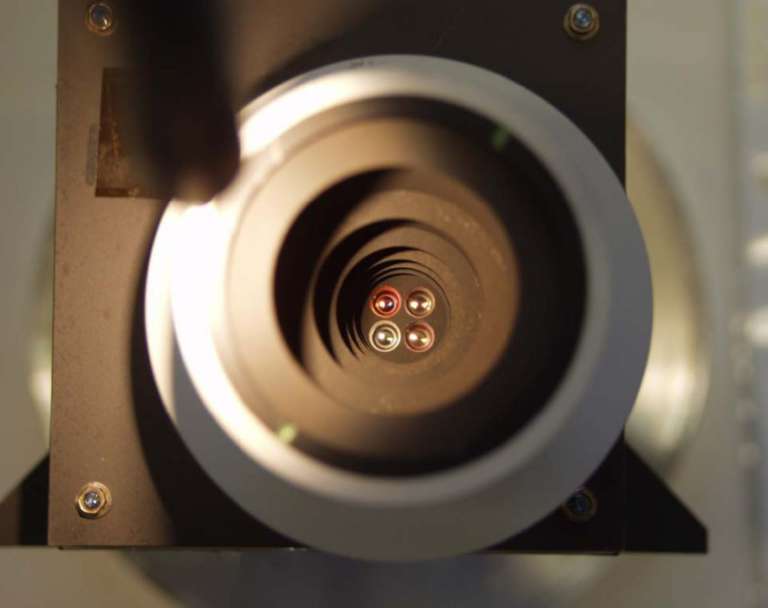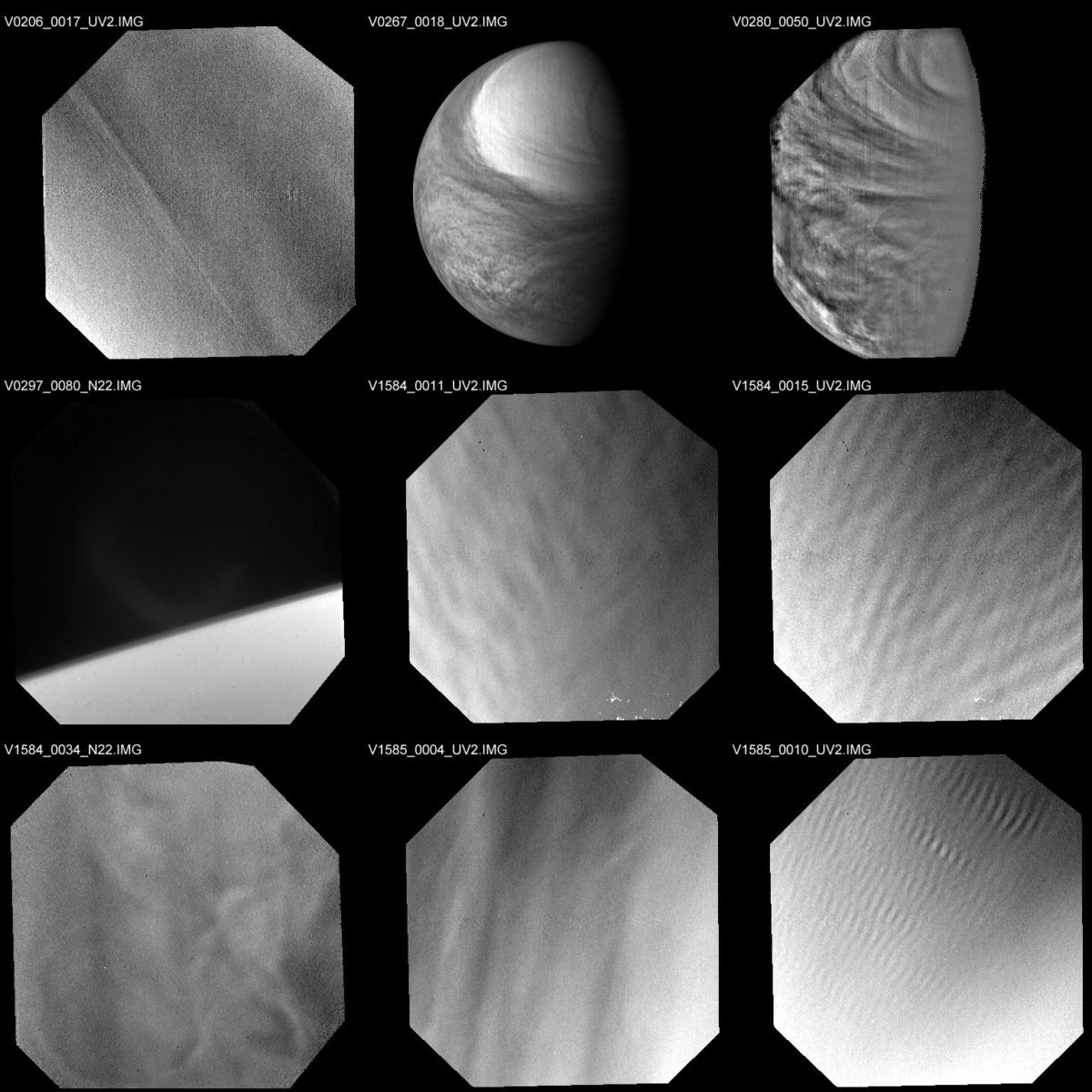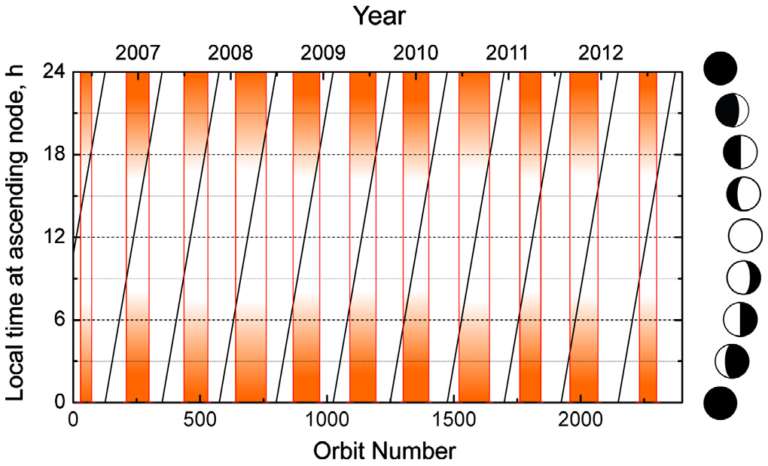Emily Lakdawalla • Aug 29, 2013
Results of ten Venus years of cloud tracking by Venus Express
When you are not the first mission to visit a planet, it can be difficult to produce scientific results that are sufficiently "brand-new" and "wow" to grab the attention of the media. "First results from X" papers abound in high-impact journals like Science and Nature. In planetary science, where we like the whiz-bang and wow of the newest results from the fanciest spacecraft sent to newest places, we tend to overlook the opposite kind of paper, the "analysis of X years of data from Y" ones that take stock of what we've learned over the lifetime of a mission.
One such paper was published in Icarus this month: "Cloud level winds from the Venus Express Monitoring Camera imaging." It represents the results of six continuous years of Venus Express monitoring the motions of Venus' clouds. That's six Earth years -- ten Venus years. It's 2299 Venus Express orbits, of which 708 were analyzed to produce nearly 450,000 wind vectors that the authors (Igor Khatuntsev and nine others) used to learn about Venus' winds and how they have changed with time. It's an important paper, because it takes a gargantuan data set, thousands and thousands of images, and distills it into a set of observations. It tells us what Venus is doing, and it challenges theorists to explain why.
We are dealing with data from the Venus Monitoring Camera. It's a somewhat unusual space camera in that it has four different color channels (one ultraviolet, one visible, two infrared) but no moving parts. Instead of a filter wheel, it has four complete optical paths, one for each channel. You can see that very clearly just by looking at the front of the camera; where you might expect to see one lens, you see four.

Those four lenses and filters collect light that is funneled through the optics onto a single CCD. Each optical path gets one corner of the CCD. The CCD is 1024 pixels square, so each channel gets 512 pixels. In practice, though, the VMC images are even smaller than that, because light from each set of optics is not allowed to encroach on the CCD areas from other sets of optics. The effect is sort of an "airplane window" view of Venus as Venus Express rounds each elliptical orbit.

In ESA's Planetary Science Archive, where you can download the Venus Express VMC data via FTP, they've divided up the data so that any one image contains only one quarter of the CCD -- so you have just the UV image, or just the NIR2 image, or whatever, each image being 512 pixels square.
Even though the images are small, an astonishing variety of features are visible in Venus' clouds. Bjorn Jonsson has spent some time playing with the data set, and put together an arrangement of pictures showing some of this diversity.

Khatuntsev and coauthors briefly described the diversity of features visible in these images, which had been described more thoroughly by previous researchers:
The UV cloud pattern is characterized by patchy and mottled features in low latitudes, streaks in middle latitudes, various wave structures, and almost featureless bright haze in the polar regions. In low latitudes (less than 40°S) cloud markings are easily identified due to their clear boundaries and relatively small sizes. Middle and high latitudes are dominated by streaks oriented along the latitude circles making the identification of longitudinal boundaries difficult and thus increasing uncertainties in the determination of the zonal [east-west] wind component. However latitudinal boundaries that affect the meridional [north-south] component determination are reliably identified.
The question whether bright and dark features are formed at the same altitude is of importance since we track both types. We argue that this is indeed the case since both measurements yield consistent results.
Another thing Bjorn noticed in the data is how the clouds can be seen to move even during the course of a single Venus Express orbit.
Venus as seen by Venus Express Venus as observed by the European Space Agency's Venus Express spacecraft during orbit 1640. The 58 images comprising the movie were obtained by the Venus Monitoring Camera instrument in ultraviolet light.Video: ESA / MPS, Katlenburg-Lindau, Germany / Bjorn Jonsson
It's this cloud motion that Khatuntsev and his coworkers tracked to get their nearly half a million wind vectors over ten Venus years. They began -- as most papers do -- by summarizing what was already known before they did their work. Here's my translation of their summary:
- In general, Venus' atmosphere is "super-rotating." Venus rotates retrograde, and its whole atmosphere does too, but the atmosphere moves around Venus much, much faster than Venus rotates. It takes roughly five days for a bit of air at the cloud level to circulate once around the planet, moving from east to west.
- At the level of the clouds that they can see (approximately 67 kilometers above Venus' surface), "the cloud level circulation has characteristics of a giant planetary vortex spiraling to the poles." This is on top of a global Hadley cell, which is the most basic kind of atmospheric motion that planets can have -- air rises at the equator (where solar heating is most intense) and sinks at the poles, so that upper-level air is moving from equator to pole, and then the air returns from pole to equator deeper down where we can't see it.
- The east-west component of wind speeds at the equator vary from roughly 88 to 98 meters per second. There is also a "mid-latitude jet," a belt of faster-moving air at about 50 to 60 degrees north and south latitude. This is more variable, from about 85 to 115 meters per second. Notice that at its lower speeds, the jet is sometimes the same speed as the regular wind speed at the equator, which makes it tough to call it a jet.
- The north-south component of wind speeds is zero at the equator, peaking at around 10 to 15 meters per second in the mid-latitudes, but there's a wide range.
- Superimposed on all this are "variable planetary waves" that travel around the planet over periods of 4 or 5 days.
- And there's a "solar locked signature," meaning that wind speeds are controlled in part by the local time of day. Venus rotates very slowly -- it takes 117 Earth days for one Venus solar day. Wind speeds are lowest at around 10 to 11 a.m., local solar time.
All of this is based upon data from Mariner 10, Pioneer Venus, and Galileo. Only one of these, Pioneer Venus, was an orbiter. When Venus Express arrived in 2007, it entered an orbit that was excellent for studying the long-term motions of the atmosphere, at least in the southern hemisphere. It has a highly elliptical orbit that takes 24 hours to complete. Because the orbit is elliptical, the spacecraft spends most of its time hanging out at a distance from the globe, with a nice view down onto the southern hemisphere. One problem, however, is that the orbit does not shift with the local time of day. Venus Express' view of Venus changes phase over the course of the Venusian year, from new to full and everything in between. This graph intends to show the periods when imaging is good enough for cloud tracking. You wind up with distinct observation "seasons," each lasting a few months and separated by a few months. This paper covers eleven such seasons.

The paper goes into great detail about their cloud tracking methods and the errors involved; I won't go into that. I'll focus instead on their results. First, the stuff that can be compared with previous work, a summary of Venus' atmospheric motion:
- Averaging all the wind measurements together provides a picture of wind speeds in Venus' southern hemisphere. Roughly speaking, from the equator down to about 40 or 50 degrees south, the winds move at a pretty constant speed, about 90 to 100 meters per second; sometimes there's a "jet" of faster-moving air at that mid-latitude region, sometimes there isn't. Wind speed then falls off rapidly from the midlatitudes to the pole. This is consistent with previous results. Always nice to see a new data set agree with an old data set!
- But think for a minute what it means that wind speeds are constant from the equator to the midlatitudes. Venus is a sphere. There is less planet to go around at the midlatitudes than there is at the equator. So it takes five days for the atmosphere to circle the planet at the equator, but only three days at the midlatitudes. From midlatitudes to the pole, the rotation period stays constant -- three days -- so the polar "cap" of the atmosphere is almost acting like a solid body, rotating around the planet as a unit. This part doesn't contradict previous results, but previous missions had little to say about the poles.
- They did some cloud tracking in infrared images, which see deeper into Venus' atmosphere than the ultraviolet images do. But they're also more difficult to interpret. They found that wind speeds seem to be slower at a deeper level, which is consistent with what was measured by descent probes like the Pioneer Venus and Venera probes.
But where the paper really gets interesting is when it talks about how things varied with time. They saw variations on just about any time scale: over the course of a single orbit, and also over the course of the 10 Venusian years of the Venus Express mission. There's never been a data set that can really get at Venus' temporal variability before, not in such detail.
- From one Venus Express observation season to the next, there were distinctly different east-west speeds of atmospheric rotation. Things poleward of those midlatitudes were pretty constant -- the polar atmosphere just sat there and rotated like a solid body once every three days, all the while that Venus Express was watching -- but the east-west motion of the low-latitude atmosphere ranged from about 80 to about 120 meters per second over the course of Venus Express' observations.
- Not only that, but there was secular change over time. The atmosphere appears to be speeding up very gradually. There's a lot of noise, but the trend is clear. " One of the main results of more than half a decade long VMC observations is that the mean zonal wind velocity in the low latitudes gradually increased from 85 ± 3 m/s in 2006 to 110 ± 3 m/s in 2012."
- There's a lot of noise because wind speeds vary a lot from orbit to orbit. They tried to look for periodicities in wind speeds, and found one at about 4.1 to 5 days, meaning that the variation in wind speeds could have to do with some kind of wave propagating around the atmosphere. Here were are getting to the limit of my ability to comprehend atmospheric science. I'm a geologist, not a weather-lady. They did say this was consistent with earlier results and that it might be a Kelvin wave. Like you, I can do a Google search on Kelvin waves in the atmosphere but I don't feel confident translating the results for you.
- There is a clear correlation between wind speed and local time of day: winds are slowest near noon and fastest in morning and evening.
What does all this mean? In particular, what does the very-short-time-scale variability of the wind speeds mean? One possibility, which makes my head hurt a bit, is hinted at in the very title of the paper. I'll remind you of it: "Cloud level winds from the Venus Express Monitoring Camera imaging." Think about clouds on Earth. They don't always form at the same altitude. Air gets pushed around and stuff in the air condenses when conditions change. They're not like floating tracer particles, but that's more or less how they've been treated in the paper. If the altitudes of the cloud tops could be changing, that would result in changes of the altitude at which the mysterious ultraviolet absorber forms, which means they're not really measuring the same place in the atmosphere from orbit to orbit, which might imply that the speed of the winds really isn't changing like it seems to be. So are we really seeing secular variation in wind speed, or are we seeing variation in the altitude at which clouds form? I can't say that the authors really provide a way to discern between the two cases, which is a little bit of a problem.
And that's pretty much it. This paper describes ten Venus years of observations. It represents experimentalists collecting data and lobbing it back to the theorists, who now have to take these results and see if the models for Venus' atmosphere that they built from Mariner 10, Pioneer, Galileo, and early Venus Express results can be made to produce data that look like this. The ball is now in the Venus climate modelers' court. Can they produce these trends over time? Can they produce the atmospheric waves? It's the next big Venus atmospheric puzzle to solve.
Venus Express is still working at Venus, so there will be more data to add in to this puzzle. But probably not a lot more. The spacecraft is running very low on fuel. ESA will certainly operate it as long as it can, but once the fuel goes, the spacecraft's orbit will decay pretty rapidly. I'll write a bit more about that in a future post.
I have one last comment that has nothing to do with the science content of the paper. It has to do with the journal editing. The paper contains many grammar and syntax errors of the kind that are common in text written by someone for whom English is not the native language. The authors of this paper are predominantly Russian, so it's no surprise that their manuscript contained such errors. In my opinion, while it is the authors' responsibility to do the best they can in their non-native tongue, it's not on them to get it perfect. It reflects badly on the journal editors (in this case, Elsevier and Icarus) to publish a paper without editing to correct grammar and syntax errors. I made a comment to this effect on Twitter, and researchers have written to me to say that academic publishing is just different from other kinds of publishing; that it's not journal editors' jobs to edit for readability. That they're just providing a publishing service for researchers -- that if an article is poorly written, it will be rejected, and if it achieves good enough quality writing so as not to obscure the science, it's accepted. It still seems kind of crazy that professional writers (like me) see our work carefully edited before print publication, while scientists don't seem to enjoy such services. Poor editing made this paper harder to read than it needed to be. Whose responsibility should it be to edit scientific papers? I welcome discussion in the comments.
The Time is Now.
As a Planetary Defender, you’re part of our mission to decrease the risk of Earth being hit by an asteroid or comet.
Donate Today

 Explore Worlds
Explore Worlds Find Life
Find Life Defend Earth
Defend Earth

